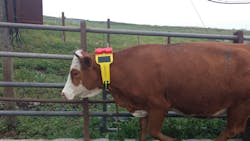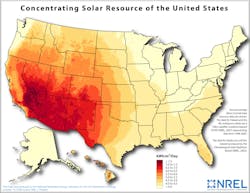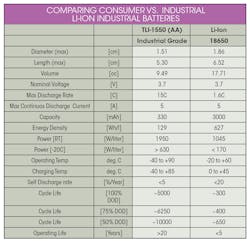Forecast is Bright for Solar/Li-Ion Battery Hybrids Powering Remote Sensors
Billions of wireless devices will soon be connected to the Industrial Internet of Things (IIoT). While the vast majority of these will be powered by primary (non-rechargeable) lithium batteries, power management challenges can occur when a wireless device has a relatively high daily power consumption. This will prematurely exhaust the primary battery, which can become highly problematic—especially for devices being deployed in hard-to-access locations and extreme environments.
Of all the energy harvesting technologies currently available, the most popular remote power supply solution involves solar PV/Li-ion battery hybrid technology. These two highly synergistic technologies offer a time-proven and increasingly cost-effective solution for powering industrial grade applications, including:
- GPS sensors
- Asset trackers
- Environmental monitoring systems
- Smart agriculture (monitoring moisture, temperature, and rainfall)
- Marine buoys
- Machine-to-machine communication
- Systems control
- Data automation (SCADA) applications
Solar/Li-ion hybrid solutions far outnumber the use of thermoelectric, electromagnetic, and piezoelectric energy harvesting devices that are deployed in highly specialized applications.
When to Deploy Solar/Li-Ion Hybrid Technology
Generally, solar/Li-ion hybrid systems should be designed to offer enough storage capacity to power a remote wireless device for a minimum of five days on a single battery charge. Otherwise, you may run the risk of experiencing a temporary system shut-down during periods of continuous rain or heavy clouds.
IPS solar-powered parking meters provide municipalities with valuable real-time data and revenue streams. Use of an industrial-grade Li-ion battery provides a highly efficient and economical solution that operates for up to 20 years to minimize long-term maintenance costs.
When calculating your panel size, you must plan for the worst months (typically December in the Northern Hemisphere) and factor in regional variances in average daily solar energy capture.
For instance, parts of Washington State receive the equivalent of just one hour of full sun per day during winter months, so the PV panel may need to be enlarged to compensate for low average daily sunlight. Conversely, many sunny desert regions throughout the Southwest can receive up to four times more average daily solar energy during winter months, thus permitting the use of smaller and less-expensive PV panels. Understanding the regional operating environment serves to ensure that your solar/Li-ion hybrid solution will provide reliable long-term wireless power.
Low-Power Design Can Cut Costs
The daily power consumption of an energy harvesting device can be influenced by numerous variables, including:
- Types of sensors used
- Energy consumed while the device is in “stand-by” mode
- Self-discharge rate of the battery
- Frequency of data collection and transmission
- Average current drawn during “active” mode, including power reserves for actuators, motors, and other advanced functionality.
For example, humidity, gas, motion, and light sensors can draw current in the 1-2 mA range, GPS sensors can draw 10-25mA of energy, and a cellular-based radio may consume up to 1 A of energy while in its “active” mode. There are various methods being deployed to reduce energy consumption, including:
- The use of low-power microprocessors and components
- Software solutions that shorten the time required for data sampling, interrogation, and transmission
- Reducing energy leakage while in “stand-by” mode
Reducing the frequency of data collection and data transmission helps conserve energy, but introduces certain trade-offs that may be avoided by specifying a larger PV panel and/or by using a greater number of Li-ion batteries for energy storage.
Many IIoT sensors and edge devices are being intelligently designed to conserve energy by reducing the clock rates of processors and controllers, adjusting the sensing frequency and broadcast frequency, and by utilizing back-off strategies to reduce communication strength. These devices also utilize low-power communication protocols such as Cat-M1, NB-Iot, LoRa, SigFox, ZigBee, and WirelessHART.
In some situations, average daily energy consumption can be reduced to the point where an energy harvesting device is no longer needed, as the vast majority of industrial-grade remote wireless devices are powered by bobbin-type lithium thionyl chloride (LiSOCl2) batteries that can operate for up to 40 years without battery replacement.
Extreme Environments Demand Industrial-Grade Solutions
Solar/Li-ion battery hybrids must be ruggedly designed to withstand the “worst-case” environmental conditions. PV panels designed for use in extreme environments should be rated to operate for a minimum of 10 years using high-efficiency cells constructed of the highest-quality materials available. If not, the performance of the PV panels could deteriorate from UV damage, delamination, or corrosion. In addition, consumer-grade Li-ion batteries are not designed to operate or recharge at extreme temperatures, thus necessitating the use of an industrial-grade Li-ion battery.
CattleWatch hub collars have built-in photovoltaic panels that harvest solar energy. Industrial grade Li-ion rechargeable batteries store this energy to deliver the high pulses required to power remote satellite-based communications between the in-herd mesh network and the rancher.
The solar/Li-ion hybrid charge circuit needs to be specifically designed to charge well from a solar panel. A panel that is rated at 6 V, 1 A will produce open circuit voltages as high as 7 V. The voltage will drop when connected to a load and continue to fluctuate with solar conditions and temperature. Likewise, current will also vary with solar conditions, temperature and angle of the panel toward the sun. There are a range of design solutions, including maximum power point chargers or linear regulators that can be deployed. Whatever you choose, be sure to capture the smallest amounts of solar energy possible, down to 1 mA, while not restricting your maximum charging rate during peak periods. A common mistake to avoid is setting a voltage target for the panel that is too high. On hot days, the panel voltage will drop and the power output could drop to zero.
Application requirements may dictate certain size and shape constraints for the PV panel, which could impact your ability to utilize an off-the-shelf solution. Custom-designed PV panels may be required based on the recommended voltage, requirements for custom coatings, and specialized mounting requirements.
The total daily estimated voltage output capacity of a PV panel is determined by its surface area and its efficiency. Monocrystalline cells typically operate at 19% efficiency, producing about 0.12 W per square inch (0.019 W per square centimeter). Back contact monocrystalline cells made by SunPower, LG, and others are capable of more than 22%. They achieve this efficiency gain by moving all or most of the contact points (which appear as thin silver lines on the solar panel) to the back, freeing up more surface area for energy production on the front of the cells.
All PV panels require some form of protective coating: glass, urethane, ETFE, epoxy, or PET. Glass offers high UV resistance, but results in added weight and increased profile, and has a risk of shattering. Urethane is highly UV-resistant and is designed to last up to 10 years. ETFE is lightweight and highly water-resistant, but will have a shorter lifespan than glass or urethane. Epoxy and PET are not recommended for most industrial applications.
PV panels need to be mounted on some form of substrate, including Aluminum-Plastic-Aluminum, PCB plastic, or aluminum. The solar/Li-ion hybrid assembly can be mounted directly to the surface of the wireless device if the PV panel is properly angled to the sun or mounted separately, if necessary.
Industrial Applications Demand Industrial-Grade Li-Ion Batteries
When an industrial-grade energy harvesting device is being deployed in a remote location or extreme environment, it is essential to specify a rechargeable Li-ion battery with sufficient energy storage capacity. In addition to five days of continuous operation, extended battery life can be critically important in remote, hard-to-access locations. The labor and travel expenses required to replace a battery can far exceed the cost of the battery itself.
The Spoondrift Spotter operates from a moored or free-drifting position to remotely measure ocean waves, position, and surface currents. Each unit features a waterproof hull, a solar panel array, a rechargeable Li-ion battery, and two-way wireless communications.
Consumer-grade Li-ion batteries are ill-suited for long-term industrial deployments, as they have an expected service life of approximately five years and 500 recharge cycles. Consumer Li-ion cells also suffer from a limited temperature range of 0°C to 60°C and are unable to deliver the periodic high pulses required to power two-way wireless communications.
In contrast, industrial-grade Li-ion batteries are now available that that can deliver up to 20-year battery life with 5,000 full recharge cycles, offering an extended temperature range of ̅̅−40°C to 85°C, and the ability to operate and recharge at extremely cold temperatures. These industrial grade batteries can also handle 15 A pulses and 5 A continuous discharge current to support two-way wireless communications and remote shut-off capabilities.
Conclusion
The burgeoning IIoT is fueling the explosive growth of remote wireless connectivity, causing rising demand for solar/Li-ion hybrids that can bring reliable long-term power supply solutions to remote locations and extreme environments.
Achieving a lower total cost of ownership demands long-term thinking, as it makes economic sense to specify a power management solution that supports robust remote wireless connectivity while minimizing future maintenance expenses.
About the Author
Jeff Crystal
COO
Sol Jacobs
VP & General Manager
Sol Jacobs, VP and General Manager for Tadiran Batteries, has over 30 years of experience in powering remote devices. His educational background includes a BS in Engineering and an MBA.






